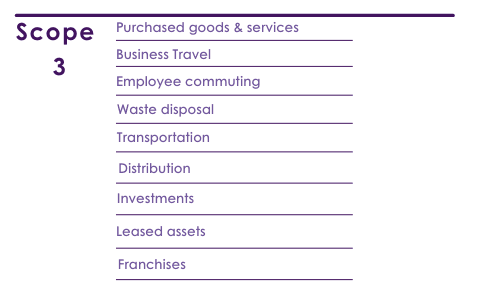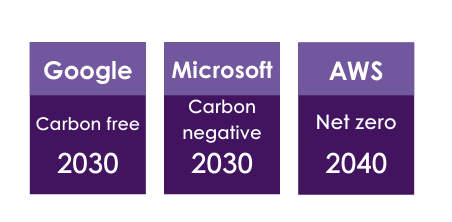Driven by the promise of reduced cost, improved productivity, and the ability to quickly scale up and down, as well as the growing use of big data analytics, artificial intelligence and machine learning technologies, businesses are rapidly migrating their IT workloads and applications to the cloud, as well as looking to streamline and optimise existing cloud architecture through a variety of tools and techniques including cloud management systems. Research published by Ericson in 2020[1], suggests that the carbon footprint of the Information and Communication Technology (ICT) sector is about 1.4% of the global greenhouse gas (GHG) emissions, including the whole life cycle for all parts of the sector (or approximately 730 million tonnes CO2-equivalent). At the same time, rules around climate governance, including mandatory GHG emission disclosure, are being adopted by more countries including the UK, the EU and the US[2].
In accordance with the Greenhouse Gas Protocol[3], GHG emissions are categorised according to “Scopes”. Scope 1 covers direct emissions from owned or controlled sources; Scope 2 covers indirect emissions from the generation of power; whilst Scope 3 includes all other indirect emissions (upstream and downstream) that occur in a company’s value (or supply) chain.
And for many businesses, it is the supply chain where the majority of its GHG emissions occur.

As a result, businesses have an increasing need to focus on value chain and supply chain sustainability (typically, 90% of an organisation’s environmental impact). According to the World Economic Forum’s Sustainable Development Impact Summit, cloud computing and data centres are a “significant driver of carbon emissions, responsible for an estimated 1.8% of US electricity consumption and the plurality of emissions for many tech companies”[4]. Moreover, Scope 3 emissions are typically aggregated into the global emissions reporting by the large cloud vendors, making it difficult to separate out an individual business’s emissions after its workload is migrated to the cloud.
But it is not all bad news!
Deploying in the cloud is significantly greener than running a traditional on-premises data centre as hyperscaler[5] cloud service providers such as AWS, Google and Microsoft are amongst the largest purchasers of renewable energy and compete on their green credentials. Google,[6] for example, has offset its historical emissions since it was founded in 1998 and has pledged to operate on 100% carbon-free energy by 2030. And Microsoft[7] has committed to be carbon negative by 2030 and (by 2050) to have removed all the carbon the company has emitted, either directly or by electrical consumption, since its inception in 1975.

In addition, the impact on the business itself can be considerable, with Accenture, a provider of information technology and consulting services, estimating that “companies with average on-premise to cloud migrations can drive 65% energy reduction and carbon emission reduction of 84%”[8].
Buyers of cloud services need to choose carefully by ensuring they have full visibility of the sustainability (or otherwise) of their third party cloud providers. Of course, ESG should not be the only selection criteria, with other factors such as cost, performance, and security, as well as target operational strategy and architecture (e.g. multi-cloud versus single-cloud, unified model - cloud and edge computing, connected device estate (IoT)) all relevant.
With expertise covering due-diligence and provider selection; negotiation, transition, implementation and exit; as well as regulatory and compliance issues such as the FCA’s cloud outsourcing guidance, UK/EU GDPR, and the recent EU Cloud Code of Conduct, Fladgate’s IT & Outsourcing team regularly advises on transactions with a cloud services component, including SaaS, IaaS and PaaS and other cloud-based solutions. Do get in touch with Tim or your usual Fladgate contact if you would like to discuss your cloud project further.
[1] What’s the real climate impact of digital technology? - Ericsson
[2] The Securities and Exchange Commission recently proposed a rule change which will require US public companies to measure and report their Scopes 1, 2 & 3 GHG emissions as well disclosing how much they rely on carbon offsets as part of their GHG reduction goals. The disclosure framework is, in large part, based on the Task Force on Climate-Related Financial Disclosures Framework and the Greenhouse Gas Protocol and, if adopted, will bring the US in closer alignment with existing UK and European disclosure requirements. SEC.gov | SEC Proposes Rules to Enhance and Standardize Climate-Related Disclosures for Investors
[3] Greenhouse Gas Protocol | (ghgprotocol.org)
[4] The next big cloud competition is the race to zero emissions | World Economic Forum (weforum.org)
[5] Hyperscale refers to the complete mix of hardware and facilities that can scale a distributed computing environment up to thousands of servers.
[6] Our Commitments | Google Sustainability
[7] Supporting our customers on the path to net zero: The Microsoft cloud and decarbonization - The Official Microsoft Blog













































































